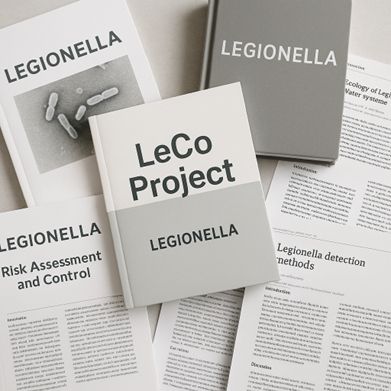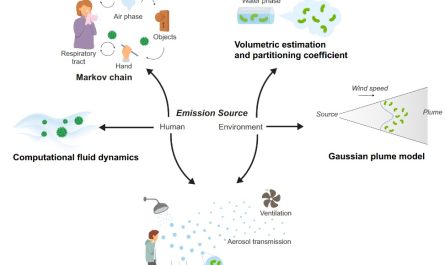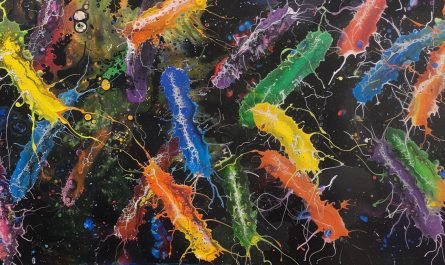Over the past five years, five multidisciplinary research groups collaborated under the LeCo project to investigate a wide range of questions surrounding Legionella and Legionnaires’ disease. , Their work addressed topics including risk assessment, source identification, detection methods, ecology, and disinfection and control strategies in building water systems. With the LeCo project now coming to an end, some data analysis and the translation of research findings into practice are still ongoing. Nonetheless, a substantial portion of the results and insights has already been shared through various local and peer-reviewed publications. All peer-reviewed papers are open access and can be downloaded via the links provided below.
Peer-reviewed publications
- Cavallaro et al. (2022): Potential probiotic approaches to control Legionella in engineered aquatic ecosystems. FEMS Microbiology Ecology 98: p.fiac071. https://doi.org/10.1093/femsec/fiac071
- Cavallaro et al. (2023): Legionella relative abundance in shower hose biofilms is associated with specific microbiome members. FEMS Microbes 4: p.xtad016. https://doi.org/10.1093/femsmc/xtad016
- Cavallaro et al. (2024): The impact of DNA extraction on the quantification of Legionella, with implications for ecological studies. Microbiology Spectrum 12(8): pp.e00713-24. https://doi.org/10.1128/spectrum.00713-24
- Fischer et al. (2023): ‘Legionnaires’ disease in Switzerland: rationale and study protocol of a prospective national case-control and molecular source attribution study (SwissLEGIO). Infection 51: 1467–1479. https://doi.org/10.1007/s15010-023-02014-x
- Margot et al. (2024): Dynamics of drinking water biofilm formation associated with Legionella spp. colonization. npj Biofilms and Microbiomes, 10: 101. https://doi.org/10.1038/s41522-024-00573-x
- Rhoads and Hammes (2021): Growth of Legionella during COVID-19 lockdown stagnation. Environ-mental Science: Water Research & Technology 7: 10-15. https://doi.org/10.1039/D0EW00819B
- Rhoads et al. (2022): Variable Legionella response to building occupancy patterns and precautionary flushing. Microorganisms 10:555. https://doi.org/10.3390/microorganisms10030555
- Sylvestre et al. (2025): Quantification of Legionella pneumophila in building potable water systems: a meta-analysis comparing qPCR and culture-based detection methods. PLOS Water 4: e0000291. https://doi.org/10.1371/journal.pwat.0000291
- Tang et al. (2024): Applications of quantitative microbial risk assessment to respiratory pathogens and implications for uptake in policy: A state-of-the-science review. Environ Health Perspect 132: 56001. https://doi.org/10.1289/EHP12695
- Tang et al. (2025): Modelling exposure to aerosols from showers: implications for microbial risk assessment. Building and Environment 275:112825. https://doi.org/10.1016/j.buildenv.2025.112825
Papers under review
- Gabrielli et al. (2024): Expansion, restructuring and characterization of the Legionellaceae family. bioRxiv. https://doi.org/10.1101/2024.10.21.619444
- Cavallaro et al. (2024): Variable inhibition of different Legionella species by antagonistic bacteria. bioRxiv, https://doi.org/10.1101/2024.11.27.625680
- Hammes et al. (2025) Foresight 2035: A perspective on the next decade of research on the management of Legionella spp. in engineered aquatic environments. FEMS Microbiology Reviews (in review)
- Tang et al. (2025): Impacts of dynamic aerosol and pathogen concentrations on risks of Legionella pneumophila for Public Showers in Switzerland Using a Quantitative Microbial Risk Assessment Framework (submitted)
Other publications
- Bigler and Mäusezahl (2025): Die Legionärserkrankung in der Schweiz: Eine nationale Fall-Kontroll-Studie zur Untersuchung von Risikofaktoren und Infektionsquellen (SwissLEGIO). BAG Bulletin, in press.
- Boss et al. (2020): Legionellen-Nachweismethoden im Vergleich – Fallabklärungen: Resultate abhängig von Analysemethode und Beprobungstechnik. Aqua und Gas. Aqua & Gas | Plattform für Wasser, Gas und Wärme | 20200608_A&G6_Legionellen-Nachweismethoden im Vergleich
- Cavallaro et al. (2021): Molekularbiologische Methoden. Charakterisierung von Legionellen. Aqua & Gas . Aqua & Gas | Plattform für Wasser, Gas und Wärme | 20211126_A&G_Charakterisierung von Legionellen
- Fischer (2023): Epidemiologische Abklärungen zu Legionellosefällen in der Schweiz. Die Planer -VDI 7 Hygienetagung. DIE_PLANER_HT_2023_Tagungsband.pdf
- Margot et al. (2021): Une étude de cas de contrôle des légionelles par la température. Aqua & Gas . Aqua & Gas | Plateforme pour l’eau, le gaz et la chaleur | 20210831_Légionelles et eau potable – étude de cas
- Mäusezahl et al. (2023): Erreger auf rätselhaftem Vormarsch. Fieldnotes (5) Wissenschaftsmagazin, R.Geigy-Stiftung. Fieldnotes No. 5 by Swiss TPH – Issuu
- Rhoads et al. (2020): Responding to Water System Stagnation in Buildings with Reduced or No Water Use: A framework for Building Managers. American Water Works Association, IAPMO. Responding to Water Stagnation in Buildings with Reduced or No Water Use
- Rölli et al. (2020): Mal schnell eine Wasserprobe nehmen. Aqua & Gas. Aqua & Gas | Plattform für Wasser, Gas und Wärme | 20201209_A&G12_Mal schnell eine Wasserprobe nehmen
- Staub and Mäusezahl (2024): Hartnäckige, ungebetene Gäste. Planer & Installateur, 4-24. Hartnäkkige, ungebetene Gäste | Gebäudetechnik
- Methode MW 101 «Untersuchung von Gebäude-Trinkwasserinstallationen auf Legionellen Beprobungsstrategie und Probenahme» (09/2021) des Schweizerischen Verein des Gas- und Wasserfaches (SVGW). Methodenkatalog | SVGW
PhD theses
- Cavallaro (2024): The diversity of interactions between Legionella species and aquatic bacteria. ETH Dissertation No. 30330. https://doi.org/10.3929/ethz-b-000698820
- Margot (2024): Legionella in biofilms: Initial colonization and impact of environmental factors. https://doi.org/10.3929/ethz-b-000704478
- Tang (2025): Quantitative microbial risk assessment of Legionella pneumophila relating shower monitoring results to infection risk outcomes. https://doi.org/10.3929/ethz-b-000730128




